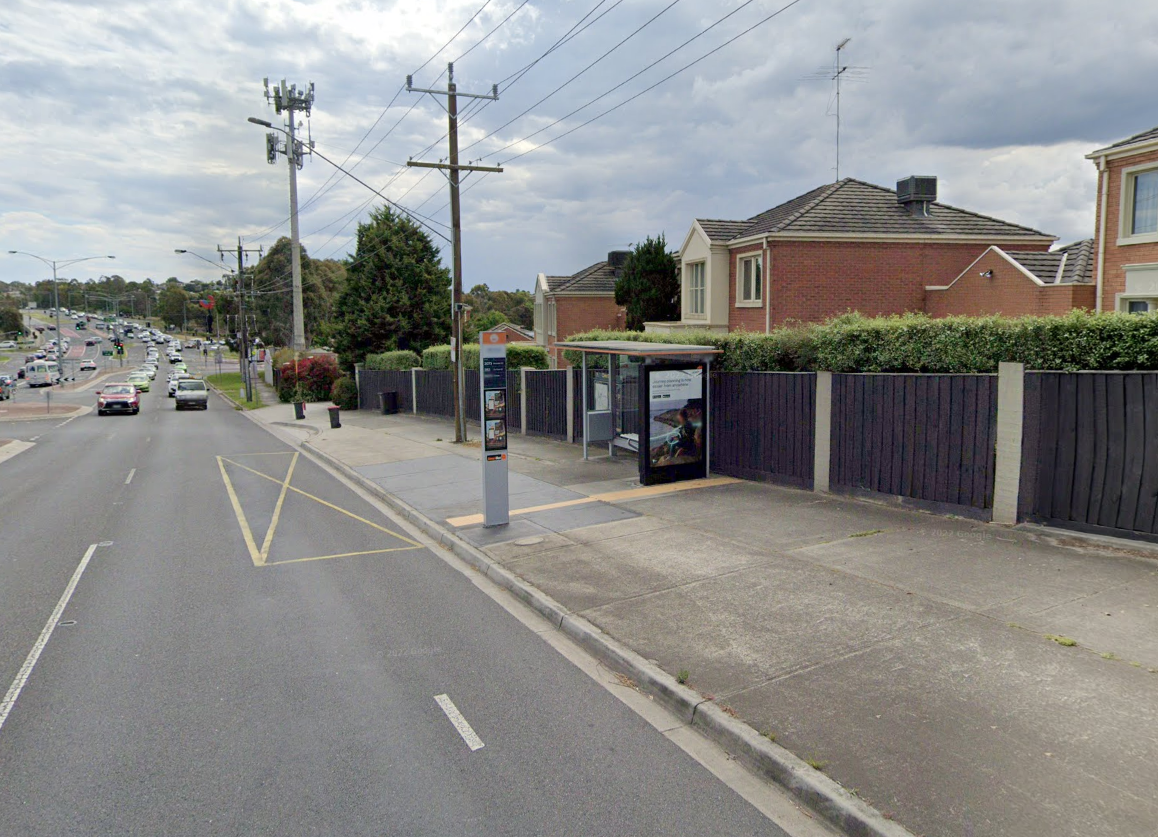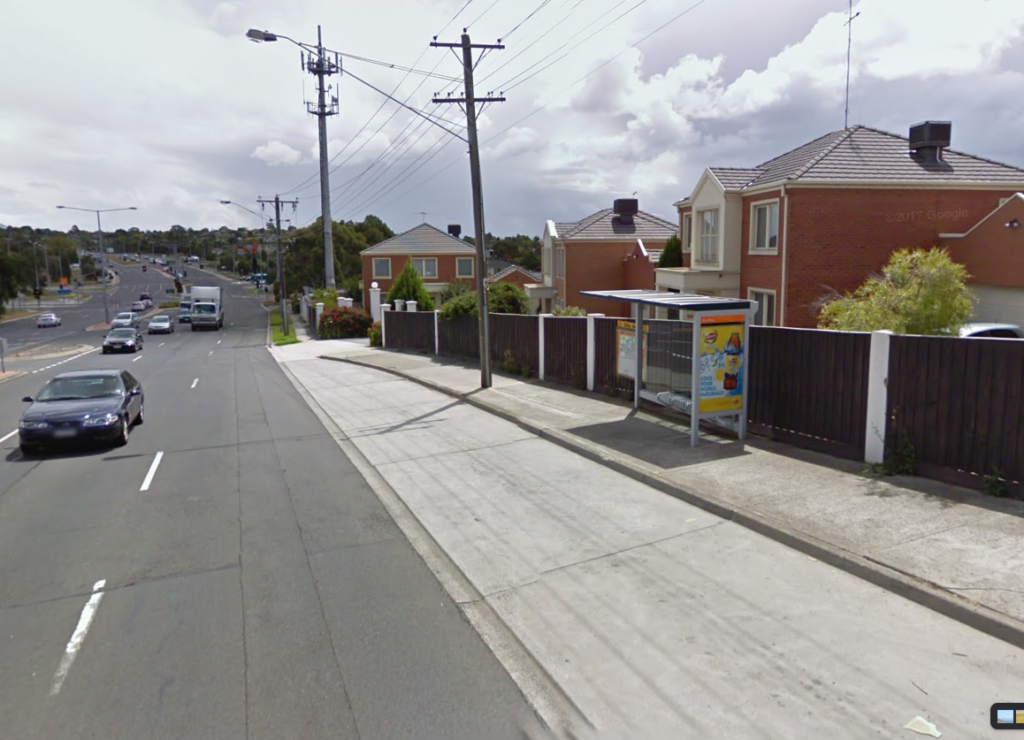Last month I wrote about the closure of the Doncaster Park and Ride bus interchange from 12 January 2025 until an unspecified date in 2028.. This is being done to make way for a temporary on-ramp for cars using the Eastern Freeway.
Afterwards I visited Doncaster Park and Ride the day after it closed to see for myself what is going on. I’m glad to see that some kind of alternative has been provided but there still things that need to be fixed.
The new bus stops
Some of you did point out in the comments of my original post that new temporary bus stops were being built at the time on Doncaster Road. You can see the results in these photos that I took on my visit below.

You don’t need to be a transport planner to see that there are some problems here. Let’s start with the physical.
Platform capacity and shelter
The new concrete bus stop platforms are far too small to cater for the large numbers of people who use Doncaster Park and Ride, especially in the morning peak. The original facility had seating and shelter continuously along the entire length of the platform (and even that wasn’t large enough at times).

This new temporary facility has only two stock shelters at the citybound stop and only one at the Doncaster-bound stop. At best these can fit maybe six people each.
The platform at the citybound stop is also very narrow. It doesn’t seem nearly large enough to accommodate the queues that build up here during some morning peaks. I suppose we will see what happens once it’s put through its paces after the summer holidays finish.

Access and interchange
I’m not an expert on the DDA but the slope of Doncaster Road is steep here and looks well outside the standard 1:20 gradient. The platform also doesn’t seem to be 1.8 metres in width at its narrowest point. It seems to me that this would prevent or at least impede someone in a wheelchair getting on or off a bus.

It’s worth noting that the old facility was almost completely flat and didn’t require people to travel to another platform or cross a road to interchange.
In some good news a zebra crossing has been built on the adjacent service lane to give legal priority to people crossing. However it is towards the bottom of a steep hill with no traffic calming and only one small sign. This may encourage people driving to speed through here without properly checking for people crossing or about to cross.

Speaking of crossings there is another problem specifically related to interchanging. At the old Park and Ride changing buses was seamless – all being done on the same long platform. However with the new temporary stops, passengers now need to change stops to switch from one bus to another across the busy Doncaster Road.

There is a signalised pedestrian crossing here but it can take a long time to cross, mainly because the signals are split into two phases. This means that you can wait 1-2 minutes for the pedestrian signal to turn green to cross to the central median and you then may have to wait another 1-2 minutes to cross to the other side. The waiting area here is also narrow and very unpleasant as you can see in the photo above.
Indented bus bays
One final point is for the Doncaster-bound stop. It seems that a lot of the project budget has been expended on halving the width of the footpath to install an indented bus bay. These are installed to keep waiting buses out of the way of other road traffic.
Without going into too much detail, indented bus bays should be avoided as a general rule. Most recent transport planning policies and guidelines discourage their use mainly because of the extra space they take up and the delays caused to buses entering and (mainly) exiting the stop.

In this case not only has this significantly reduced the amount of space that pedestrians can now use and potentially delayed buses but it is also a real ‘back to the future’ moment.
This is because the new, indented bay actually reinstates an old indented bus bay that was removed here in about 2011 to provide a better walking environment and reduce bus delays. You can see it here in some old Google Streetview photos.


They’re all the physical aspects so let’s now move on to the ‘soft’ parts.
Wayfinding and access
Obviously I went here knowing that Doncaster Park and Ride is closed. But in the 30-40 minutes that I was there I saw no fewer than three people walk through to the old facility and sit down to wait for a bus.
I can only assume that this is because there was hardly any indication at all that the bus stop was closed. There was only one sign at the site indicating that Doncaster Park and Ride is closed and even then this was aimed at car drivers, positioned within the carpark entrance and telling people to drive to Bulleen Park and Ride – which obviously isn’t an option for people who’ve walked there.

Nearby construction workers had to walk over and tell all three of these people (who arrived at different times) that it was closed and they had to use the new temporary stops. I think this will get better as regular passengers get used to the new arrangements and construction goes ahead but this is a very easy problem to avoid in the first place.
The old Doncaster Park and Ride had some of the best wayfinding and facilities of any bus stop in Melbourne. There were up-to-date area network maps, large timetables and live departure screens. Unfortunately none of these are present at the temporary stops.

The only thing that’s been carried over are the printed timetables and even then they are the standard small format.
Summary
Overall it seems that whoever planned this major disruption assumed that all or most people get to and from Doncaster Park and Ride by car.
There are many signs of this, including all of their on-site and online communications telling people to “drive” to Bulleen Park and Ride as an alternative. You can also see this in the way that new bus movements have been organised and the lack of information generally on bus operations at the new temporary stops.
Assuming that all or most people drive here is not correct. According to the latest figures publicly available from PTV for 2018-19 there were over 1,000 recorded boardings per day. Note that this is also a large underestimate as it only includes boardings for passengers starting a new trip because it is only raw myki data. This means that it excludes people interchanging, alighting and anyone who did not touch on for whatever reason.
Doncaster Park and Ride had around 380 – 400 car parking spaces (I can’t find an exact figure). Even assuming that every space was full all the time this is less than half of even the raw myki trips recorded.
As I said in my previous post on this topic – and many times before – disruptions happen and they are often unavoidable. It’s almost impossible to avoid all inconvenience or problems but there is a lot that can be done to minimise them and make the experience for travelling passengers as pleasant and easy as possible.
Unfortunately in this case the temporary alternative could have been a lot better. As discussed above this is an important interchange for many people and also services a large walking and cycling catchment in its own right. Not only is this because multiple routes terminate or converge here but also because of its (now former) facilities like good weather protection, toilets, maps, seating and drinking water. None of these things have been provided – or provided inadequately – and does not encourage people to use the bus.


Leave a Reply